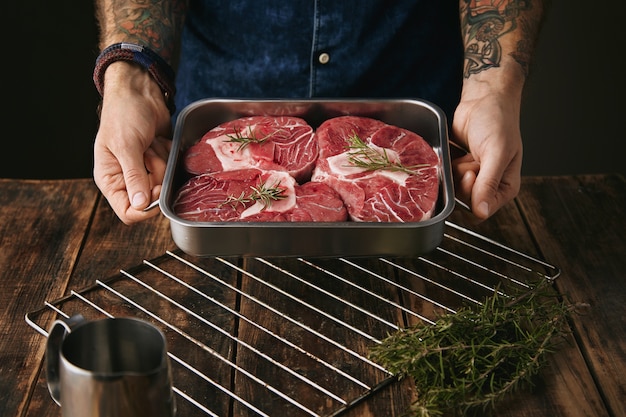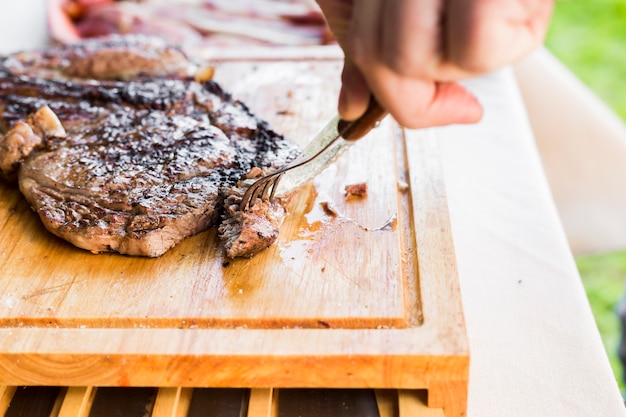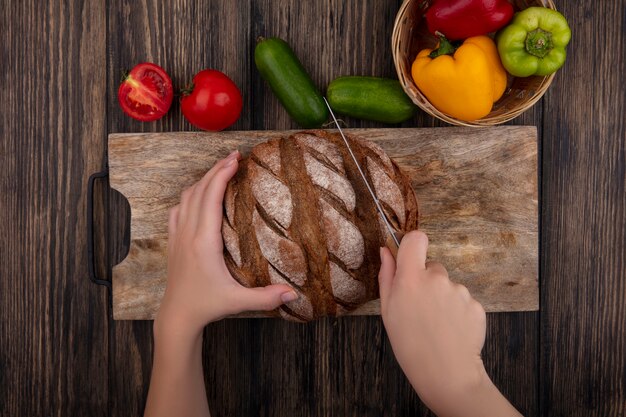Ever feel like you're stuck in a rut when it comes to dinner? Same old chicken breast, or maybe a burger? Well, let me introduce you to a cut of beef that's packed with flavour and can be just as versatile: flank steak. It's a real bargain too, which is always a bonus! But here's the thing - flank steak can be a bit tricky to cook if you're not careful. One wrong move and you'll end up with a chewy, dry disaster.
Don't worry! I've been there, and let me tell you, I've learned a few tricks along the way. I've even managed to convince my mates that I'm some kind of culinary genius when I serve up a perfectly cooked flank steak. I'm here to share all my secrets with you, so you can impress your friends and family with your newfound steak-cooking skills.
(Part 1) What is Flank Steak?

Flank steak is a cut of beef that comes from the abdominal muscles of the cow. It's a bit like the "six-pack" of the cow! It's often labelled as "london broil" or "bavette steak," which is a bit confusing, but just remember, it's all the same thing. Now, you might be thinking, "Abdominal muscles? Isn't that going to be chewy?" You're not wrong. Flank steak is a tough cut of meat, meaning it's got a lot of connective tissue. But, that's not necessarily a bad thing! It's actually a key to its flavour. It just means we need to cook it right to break down that connective tissue and make it melt-in-your-mouth tender. Think juicy, flavorful bites with every chew.
(Part 2) Choosing the Right Flank Steak

Alright, so you're ready to tackle flank steak. But how do you pick the perfect piece? Here's what to look for:
2.1) Colour and Marbling
A good flank steak should have a deep, rich red colour. You want to avoid any greyish or purplish tones, as that might mean it's not as fresh. You should also look for marbling, which are those streaks of fat running through the meat. Marbling is like the secret ingredient for flavour and juiciness. The more marbling, the better!
2.2) Texture
When you pick up the steak, it should feel firm to the touch. Think of it like a good handshake - a little bit of give, but not mushy. That firmness means it's fresh and will cook up nicely.
2.3) Understanding Meat Grades
In the US, you'll see "Prime", "Choice", and "Select" grades on the meat. "Prime" is the highest grade and you'll pay a little more for it. "Choice" is a great middle ground and usually more affordable. "Select" is a lower grade and you'll find it at the lowest prices.
(Part 3) Preparing the Flank Steak

You've got your beautiful piece of flank steak! Now let's get it ready for cooking.
3.1) Trimming the Fat
Have a good look at your steak and trim away any excess fat. You can leave a little bit, but don't go overboard - a lot of fat will just render out during cooking and make the steak greasy. Remember, we want juicy and flavorful, not greasy.
3.2) Tenderizing the Steak
Flank steak is tough, so we need to help it relax a bit before cooking. There are a few ways to do this:
3.2.1) Using a meat tenderizer
A meat tenderizer can be your new best friend when dealing with flank steak. It's a handy little tool that physically breaks down the muscle fibres, making the steak more tender. Just be gentle - you don't want to end up with a mushy steak!
3.2.2) Marinating the Steak
Marinating is another great way to add flavour and tenderize the steak. The acidic ingredients in the marinade break down those tough proteins. For flank steak, I love a marinade with soy sauce, Worcestershire sauce, olive oil, garlic, and a little bit of citrus juice, like lemon or lime. Let the steak soak in the marinade for at least an hour, or even better, overnight. It's like giving the steak a little spa treatment!
(Part 4) Cooking Methods for Flank Steak
Alright, your flank steak is prepped and ready to go! Now, let's talk about the best ways to cook it. There are three main methods that work wonders with flank steak: grilling, pan-searing, and slow-cooking. Each one brings its own unique flavour and texture to the table.
4.1) grilling flank steak
Grilling is the classic way to cook flank steak. That high heat creates a beautiful sear on the outside while keeping the inside juicy and tender. Here's the grill game plan:
4.1.1) Prepping the Grill
Get your grill nice and hot, medium-high heat is the goal. If you're using gas, heat one side of the grill to medium-high and let the other side stay on low. If you're using charcoal, use a few briquettes for direct heat and spread out some more on the side for indirect heat. We'll use the direct heat for searing and the indirect heat for finishing.
4.1.2) Grilling the Steak
Time to get that steak on the grill! Place it on the hot side, making sure it's parallel to the grill grates. Close the lid and let it sear for about 4-5 minutes on each side, until you get a nice, dark crust. The key here is to resist the urge to move it around too much. Let it sear! Now, move the steak to the cooler side of the grill, close the lid, and let it cook until it reaches your desired level of doneness. This will take about 5-7 minutes more. You can use a meat thermometer to check the internal temperature if you want to be super precise.
4.1.3) Resting the Steak
Don't forget this crucial step! Once the steak is cooked, take it off the grill and let it rest for at least 5-10 minutes before slicing. This allows the juices to redistribute, resulting in a more tender and flavorful steak. It's a little bit of patience that pays off big time!
4.2) pan-searing flank steak
Pan-searing is a great option when you don't have a grill handy. It uses similar high heat to achieve that lovely crust and juicy interior.
4.2.1) Prepping the Pan
Start by heating a heavy-bottomed skillet over high heat. A cast iron skillet is ideal, but any heavy-bottomed skillet will work.
4.2.2) Searing the Steak
Add a tablespoon or two of oil to the hot skillet. Once the oil is shimmering, add the flank steak. Let it sear for 4-5 minutes on each side, until it's beautifully browned. Then, reduce the heat to medium and cook for another 5-7 minutes, until the steak reaches your desired level of doneness. Again, a meat thermometer can be your trusty sidekick here.
4.2.3) Resting the Steak
Just like with grilling, let the steak rest for 5-10 minutes before slicing. It's the same principle - those juices need a little time to chill out and redistribute.
4.3) Slow-cooking flank steak
Want a steak so tender it practically melts in your mouth? Slow-cooking is your best bet. It's perfect for breaking down those tough muscle fibres and giving you a truly melt-in-your-mouth experience. You'll need a slow cooker or dutch oven for this.
4.3.1) Seasoning the Steak
Before you pop the steak into the slow cooker, give it a good seasoning with salt, pepper, and any other spices you fancy. Think garlic powder, onion powder, paprika - get creative!
4.3.2) Slow-Cooking the Steak
Place the seasoned flank steak in the slow cooker, adding a little bit of liquid to the bottom, like beef broth or water. Cover the slow cooker and cook on low for 6-8 hours, or on high for 3-4 hours. The steak should be fork-tender, meaning it practically falls apart when you poke it with a fork.
4.3.3) Shredding the Steak
Once the steak is cooked, use two forks to shred it apart. You can then add it to a sauce, use it for tacos, burritos, or even sandwiches.
(Part 5) Determining Doneness
We're getting close to the finish line! Now, let's figure out how to tell when your flank steak is cooked to your liking. There are two main ways to check:
5.1) Using a Meat Thermometer
The most accurate way to determine doneness is with a meat thermometer. Insert it into the thickest part of the steak, making sure you avoid touching the bone. Here are the recommended internal temperatures for flank steak:
| Doneness | Internal Temperature (F) | Internal Temperature (C) |
|---|---|---|
| Rare | 125-130°F | 52-54°C |
| Medium-Rare | 130-135°F | 54-57°C |
| Medium | 140-145°F | 60-63°C |
| Medium-Well | 150-155°F | 65-68°C |
| Well-Done | 160°F or above | 71°C or above |
5.2) The Touch Method
If you don't have a thermometer, you can also gauge the doneness by touch. Gently press the centre of the steak with your finger. Here's a guide:
- Rare: The steak will feel soft and springy
- Medium-Rare: The steak will feel slightly firmer and have a slight give
- Medium: The steak will feel firmer and have a little resistance
- Medium-Well: The steak will feel firm and have a lot of resistance
- Well-Done: The steak will feel very firm and have no give
(Part 6) Resting the Steak
We've almost reached the end of our journey! Now, we need to let the steak rest. It might sound a bit boring, but trust me, it's a crucial step. Resting the steak allows the juices to redistribute throughout the meat, making it juicy and tender. It's like giving the steak a chance to catch its breath after a good workout. Let it rest for at least 5-10 minutes before slicing.
(Part 7) Slicing the Flank Steak
Alright, your steak has rested and it's ready to be sliced. Now, here's the thing: there's a right way and a wrong way to slice flank steak. To avoid a tough and chewy steak, slice it against the grain. This means you slice perpendicular to the direction of the muscle fibres.
If you cut with the grain, you're cutting through the muscle fibres, resulting in a tough and chewy steak. But, by slicing against the grain, you're cutting across those fibres, making the steak more tender. Think of it as a tenderizer that you can hold in your hand!
(Part 8) Serving Flank Steak
Finally, your flank steak is cooked to perfection, it's rested, and it's sliced beautifully. It's time to serve it up and enjoy the fruits of your labour!
8.1) Sauce Options
Flank steak is a blank canvas when it comes to sauces. Here are some of my personal favourites:
- Mushroom Sauce: The earthy flavours of mushroom sauce complement the rich flavour of the steak perfectly.
- Garlic Butter Sauce: A classic sauce that's easy to make and always a crowd-pleaser.
- Red Wine Sauce: A rich and complex sauce that pairs well with the flavour of the steak.
- steak sauce: A classic steak sauce, but you can also get creative with chimichurri or chimichurri-style sauces.
8.2) side dish Suggestions
Flank steak is a real team player when it comes to side dishes, but here are a few of my go-to's:
- mashed potatoes: A classic and comforting side dish that pairs well with any steak.
- Roasted Vegetables: Roasted vegetables, such as carrots, broccoli, or Brussels sprouts, add a nice pop of colour and flavour to your plate.
- rice pilaf: A flavourful and easy-to-make side dish that's perfect for soaking up the juices from the steak.
- Salad: A fresh salad adds a nice contrast to the richness of the steak.
(Part 9) Storing Leftovers
Got some leftover flank steak? Lucky you! It's best to store it in an airtight container in the refrigerator for up to 3-4 days. You can reheat it in a skillet or microwave.
Remember, flank steak is a very versatile cut of meat. It can be used in a variety of dishes, from stir-fries to tacos. So, don't be afraid to get creative with your leftovers.
(Part 10) FAQs
Got some burning questions about flank steak? I'm here to answer them!
10.1) How long should I cook a flank steak?
The cooking time for a flank steak depends on the method you're using and the thickness of the steak. For grilling and pan-searing, it will take about 8-12 minutes total, depending on the level of doneness you desire. For slow-cooking, it will take about 6-8 hours on low, or 3-4 hours on high. Remember, you want that steak fork-tender!
10.2) Can I freeze flank steak?
Yes, you can freeze flank steak. To freeze it, wrap it tightly in plastic wrap, then place it in a freezer-safe bag and squeeze out the air. It can be frozen for up to 3-4 months. To thaw it, transfer it from the freezer to the refrigerator and let it thaw overnight.
10.3) Can I use a marinade for flank steak?
Absolutely! Marinating flank steak is a great way to add flavour and tenderness. I recommend using a marinade that's acidic, such as one that contains lemon juice, lime juice, or vinegar. These acids help to break down the tough proteins in the meat, making it more tender.
10.4) What are some good recipes for flank steak?
There are loads of delicious recipes for flank steak! Here are a few to get you started:
- Grilled Flank Steak with chimichurri sauce: A classic and flavourful dish that's perfect for summer grilling.
- flank steak tacos: A quick and easy weeknight meal that's always a crowd-pleaser.
- Flank Steak Stir-Fry: A delicious and healthy meal that's packed with flavour and nutrients.
10.5) What are some tips for cooking flank steak?
Here are a few final tips to ensure your flank steak is a winner:
- Don't overcook it: Flank steak is best cooked medium-rare or medium. Overcooking it will make it tough and dry.
- Slice against the grain: Cutting against the grain helps to tenderize the steak.
- Rest the steak: Let the steak rest for at least 5-10 minutes before slicing.
- Use a meat thermometer: This is the most accurate way to determine the doneness of your steak.
There you have it, my friend! Everything you need to know about cooking flank steak to perfection. Now go forth and create some amazing dishes! And remember, you don't have to be a culinary genius to impress with flank steak. Just follow these tips, and you'll be the envy of all your mates.
Everyone is watching

Corn on the Cob: The Ultimate Guide to Perfectly Cooked Ears
Healthy MealsAh, corn on the cob. Just the name evokes images of sunny days, barbecues, and that sweet, juicy flavour that ...

Perfect Pork Roast Oven Cooking Time: A Guide to Delicious Results
Healthy MealsThere's something truly satisfying about a perfectly roasted pork. The aroma alone is enough to make your mout...

Ham Cooking Time: How Long to Bake, Smoke, or Boil a Delicious Ham
Healthy MealsAh, ham. It's a classic, isn't it? A real crowd-pleaser, especially around holidays. And when done right, it'...

Scallops: The Ultimate Guide to Perfect Cooking
Healthy MealsAh, scallops. Those delicate, sweet, and utterly delicious morsels of the sea. They hold a special place in my...

Spaghetti Squash: The Ultimate Guide to Cooking and Serving
Healthy MealsRemember that time you saw spaghetti squash at the supermarket, looking all bumpy and strange, and thought, "W...
